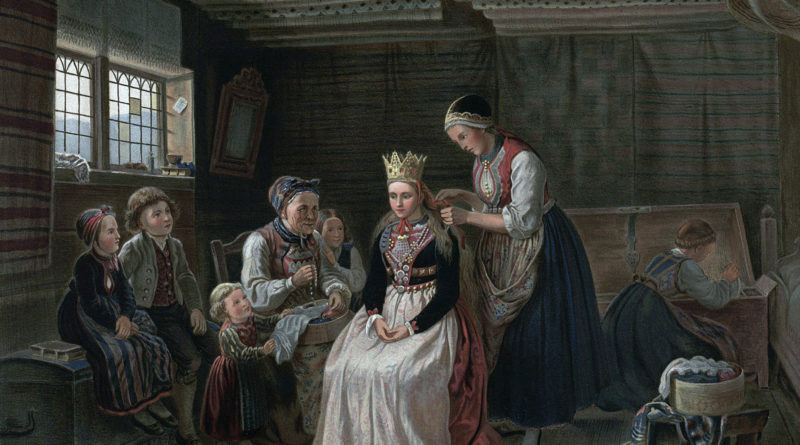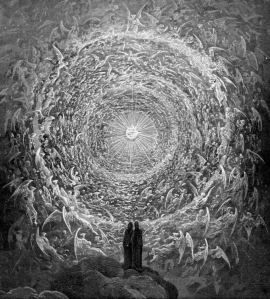
Anyone who has spoken to me in the past couple months must have found themselves scandalized by the fact that I have become obsessed with a woman. I would spend all my free time with her, running to her whenever I had a spare moment, and not leave her until the small hours of the morning. The woman I am speaking of is, of course, Kristin Lavransdatter by Sigrid Undset.
To describe the reaction of my conversation partners as scandal may perhaps be an exaggeration. I have, in reality, found their reactions to be rather much less than such a book deserves. A usual interaction is as follows:
Me: This book is killing me.
Other person: What book?
Me: Kristin Lavransdatter.
Other: Whose daughter?
Me: Lavransdatter. It’s this really great novel that follows the life of a Norwegian woman in medieval Norway throughout her entire life.
Other: …
Me: It’s really good!
Other: …
I was forced to conclude that I need to work on my pitch. So here it goes.
Kristin Lavransdatter follows the life of one woman in fourteenth century Norway through three books: The Wreath, The Wife, and The Cross, usually published in one volume. It was written in the 1920s by Sigrid Undset, a Norwegian woman already well-known for her novels set in contemporary Norway. However, she had always maintained a passion for the Middle Ages, which was nurtured by her archaeologist father. Undset would go on to convert to Catholicism in 1924, two years after the last volume of Kristin Lavransdatter was published. She received the Nobel Prize in literature in 1928.
When I first started this book, I put it down for a few months after about forty pages. The pace was incredibly slow, and I had trouble imagining how I could survive over 1,000 pages of this kind of writing.
However, after Kristin advances into womanhood, the plot takes a turn toward a typical romantic plot, and I have to admit that that is primarily drew me into the book. Yet there was something else, something quieter, which was unfolding in this reading.
Before I began reading the book, I attended a talk given by a Dominican friar about the works of Sigrid Undset, which gave me a key to understanding the book. He said the book is as much about Kristin’s father, Lavrans Bjørgulfsøn, as it is about Kristin, and he is meant in some sense to be an image of God the Father.
And on a superficial level, the importance of Lavrans is obvious from the first page. The book begins with a history of his marriage to Kristin’s mother and the property transactions involved therein. Additionally, we see that as a young girl, Kristin has an unusually close and affectionate relationship with her father.
But what woke me up to this was the charming interaction young Kristin has with a Franciscan friar, Brother Edvin. I had read a blog post about this book, praising it for brimming with passion and action, including predatory priests (was that really meant to be a selling point?). So I cautiously read this exchange, prepared for the worst, but was pleasantly surprised by its sweetness and beauty. And of course, my pleasure in this scene came from the fact that it was a positive portrayal of a Catholic priest for once. But it was also something deeper. For once, I was reading a book that portrayed fatherhood in an positive light.
The predatory priest appeared later, of course, but that was a flash in the pan. What remained was the deep love of Lavrans for his daughter, brought out in a later exchange between Brother Edvin and Kristin.
“We have done so much wrong to come this far. And worst of all is this gnawing at my heart that I have caused my father such great sorrow. He’s not happy about this either. And yet he doesn’t know…if he knew everything, then he would surely withdraw his affection from me.”
“Kristin,” said Brother Edvin gently, “don’t you understand, child, that this is why you must never tell him, and why you must not cause him any more sorrow? Because he would never demand penance from you. Nothing you do could ever change your father’s heart toward you.” (253)
Context is not needed to understand the gist of this conversation, and it is better without it in order to avoid spoilers. Yet we see here in Kristin the fear of the Prodigal Son, ashamed to return to his father’s house. Indeed, one of the most moving parts of the book for me was much later on when Undset directly quotes this parable: “I will rise up and go to my father” (1083). Almost at the end of the book, the connection between Kristin’s relationship with God and her relationship with her father is brought into even greater relief in an exchange with another priest:
“You loved God the way you loved your father: not as much as you loved your own will, but still enough that you always grieved when you had to part from him. And then you were blessed with having good grow from the bad which you had to reap from the seed of your stubborn will.” (1095)
Finally, I was struck from the beginning by the use of patronymics throughout the book. In the very title of the book, the main character is referred to in relation to her father: Kristin Lavransdatter (“Lavransdatter” means “daughter of Lavrans”). The name Kristin also comes from “Christ,” perhaps deepening the connection between Lavrans and the Father.

It may seem ironic that in a story which focuses so much on motherhood, I have spoken almost exclusively about fatherhood. However, the intimate descriptions of motherhood throughout the book were also enchanting. In some ways, I was mourning the loss of the familial atmosphere of the Middle Ages and praying that we could return to a greater respect for the family.
Kristin Lavransdatter was one of the first books I read in which I felt I was reading about a real adult character. Doubtless this is in large part due to my changed perspective as a young adult myself, but so many novels seem to be about people who are still children or people grasping toward adulthood or people who were born grownups. In Kristin Lavransdatter, Kristin passes from girlhood to womanhood to motherhood and has to make the choices and sacrifices of adulthood. She carries the guilt of her past sins and resentment for sins committed against her. She resolves time and again to forgive and to atone for her sins and then falls again into the same sin of unforgiveness. As an adult, she has to accept her limitations and get back up again.
Perhaps it is the realism of continual conversion that attracts me. Kristin is not converted once and then stays on the straight and narrow. She is continually struggling with the same sins and resentment and dealing with their disastrous consequences. Secular readers often complain that Undset’s books are about people who wallow unnecessarily in guilt for a sin they committed years ago. But that is the point of the book. It is a book about forgiveness. The characters in Kristin Lavransdatter wallow in guilt because they cannot forgive themselves and consequently can’t forgive others and this is what keeps them from moving forward.
But when she stood before the cross, whispering her Pater noster, and she came to the words sicut et nos dimmittibus debitoribus nostris [as we forgive our debtors], then she would feel her heart harden, the way a hand clenches into a fist to strike. No!
Without hope, her soul aching, she would weep, for she could not make herself do it. (941)

Another dimension of this is brought out earlier when Simon Andressøn also reflects on the Our Father.
It was strange that the Lord hadn’t also taught them to pray: “sicut et nos dimittibus creditoribus nostris.” [as we forgive our creditors] He didn’t know whether this was proper Latin; he had never been particularly good at the language. But he knew that in some way he had always been able to forgive his debtors. It seemed much harder to forgive anyone who had bound a debt around his neck. (804)
In all this, I suppose I am gesturing toward the rich realism of the book. Up to now, my favorite novel had been Anna Karenina by Leo Tolstoy, of whom it was said, “If the world could write itself, it could write like Tolstoy.” And I agree with this quote for the most part. Nothing escapes Tolstoy’s lamplike gaze in his novels. It is the conclusions he draws from these deep observations which are often problematic. It is as if he is unsure what is most important in the vast panorama he is painting, and the result is, at best, the controversial first line of Anna Karenina (“Happy families are all alike; each unhappy family is unhappy in its own way.”), and at worst, the unnecessary verbosity of War and Peace.
Undset has something of Tolstoy’s lamplike gaze, yet she is adept at guiding the many characters on her vast canvas to their goal. They talk, act, move, fall in love, sin, repent, and die like real people. They also escape Tolstoy’s idealism. Kristin’s motherhood is rarely like the blissful motherhood of Kitty Levin in Anna Karenina. And I only realized that fact when the two worlds of Kristin’s and Kitty’s motherhood momentarily overlapped. In many ways, Undset’s realism is more robust. Her story has a point, but she does not manipulate the world in order to make it.
That’s I said the story was killing me—or better, wounded me—because the characters were like real people in almost every sense of the word. No character was outside this reality for simply being a “main character.” Yet the book taught me that a book is not more real simply for having lots of bad things happen to people. Any hack writer can do that. It was real because the cruel world of Kristin Lavransdatter was also created by a loving Father, gently interacting with the human will through grace. Like beauty, this book wounded me, so I could be put back together again.
You can buy the book here.






